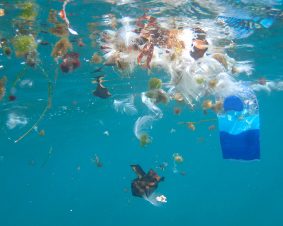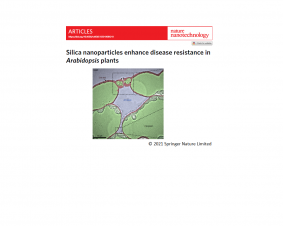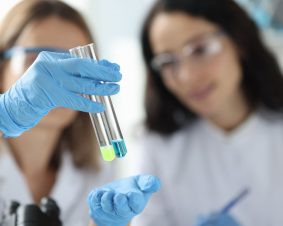 >
Spotlight November 2021: Safe Materials from Scratch – Safe-by-Design in Materials Research
>
Spotlight November 2021: Safe Materials from Scratch – Safe-by-Design in Materials Research
Advances in the field of materials science continue to amaze us with nanoscale materials with extraordinary chemical, electrical, optical, and numerous other properties. However, some nanoscale materials have different toxicological profiles compared to the same bulk material. Since safety issues are usually addressed just before launching a product into the market, safety issues may be discovered too late, thus resulting in a lot of wasted effort. This month we want to highlight a two-part research paper. This paper proposes a Safe-by-Design (SbD) strategy to link materials functionality with environmental and human safety allowing innovators to anticipate potential safety issues in the early stages of the innovation process. Therefore, unleashing the full economic potential of innovative nanoscale materials.
The SbD strategy aims to reduce uncertainties in materials research and development and, at the same time, raise human and environmental safety. The proposed strategy ensures the collection of safety-related data throughout the whole development process complying with regulatory requirements and ensuring a transparent communication of risks from early in the innovation process onwards. The authors adapt the Cooper’s stage-gate-model – a project management technique usually used for product development – by including new decisive parameters for the decision-making during the innovation process. Moreover, the authors offer a comprehensive overview of the information needed to balance safety and functionality and illustrate the applicability of the SbD strategy using a case study: Carbon nanotube-based transparent conductive films. Whereas the second part of the paper concentrates on the applicability of SbD, the first part offers a set of questions to identify which type of information is required to assess and reduce environmental and human risks. These questions allow innovators to find, prioritize, and choose safer alternatives.
Original publications:
Tavernaro, I., Dekkers, S., Soeteman-Hernández, L. G., Herbeck-Engel, P., Noorlander, C., and Kraegeloh, A. 2021. Safe-by-design part II: a strategy for balancing safety and functionality in the different stages of the innovation process. NanoImpact, 24, 100354. DOI: 10.1016/j.impact.2021.100354
Dekkers, S., Wijnhoven, S. W., Braakhuis, H. M., Soeteman-Hernandez, L. G., Sips, A. J., Tavernaro, I., Kraegeloh, A., and Noorlander, C. W. 2020. Safe-by-Design part I: Proposal for nanospecific human health safety aspects needed along the innovation process. NanoImpact, 18, 100227. DOI: 10.1016/j.impact.2020.100227
Weitere Spotlights
Spotlight October 2022: The titanium dioxide debate – why the current ECHA and EFSA hazard classification should be questioned
Due to various reports and scientific studies, titanium dioxide (TiO2)was also banned in Europe this year (2022) for use as a food additive with the indication that it could possibly be carcinogenic to humans. Although no case of tumour induction in humans has been reported since the use of this material in micro but also […]
Read moreSpotlight July: Plastic Pollution and the Urgent Need for Comprehensive Action
Plastic pollution has become a significant threat to the oceans, biodiversity, and ecosystems worldwide. Despite efforts to reduce plastic consumption, escalating plastic production continues to increase the magnitude of plastic pollution in the environment. In response to this crisis, the UN-Environmental Assembly (Link) adopted a resolution in March 2022 to develop a legally binding treaty […]
Read moreSpotlight December 2021: Silica nanoparticles improve plant disease resistance
The resistance of plants to various pathogens is often increased in agriculture with various chemicals (“fertilizers”). A new direction is being taken with the use of nanoparticles. These can be sprayed on the plants. In the present study, the model plant Arabidopsis was used to investigate whether silicon dioxide nanoparticles (SiO2) can increase resistance to […]
Read moreSpotlight September 2023: Fishing for raw materials with proteins
The so-called rare earth elements such as neodymium, dysprosium or cerium are elements that are of great importance for the energy transition; among others they serve as components of magnets in generators for electric power generation, act as luminescent materials in energy-saving lamps or as part of the car exhaust catalytic converter. The global production […]
Read more


